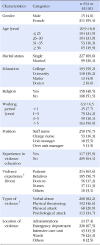|
|
| 1. |
Ditmer DA. Safe environment for nurses and patients: halting horizontal violence. Journal of Nursing Regulation 2010;1(3):9–14.
|
|
| 2. |
Kennedy M, Julie H. Nurses' experiences and understanding of workplace violence in a trauma and emergency department in South Africa. Health SA Gesondheid 2013;18(1):1–9. [doi: 10.4102/hsag.v18i1.663]
|
|
| 3. |
Hahn S, Zeller A, Needham I, Kok G, Dassen T, Halfens RJG. Patient and visitor violence in general hospitals: a systematic review of the literature. Aggression and Violent Behavior 2008;13(6):431–441. [doi: 10.1016/j.avb.2008.07.001]
|
|
| 4. |
Jackson D, Wilkes L, Luck L. Cues that predict violence in the hospital setting: findings from an observational study. Collegian 2014;21(1):65–70.
|
|
| 5. |
Soares MH, de Vargas D. The translation and cultural adaptation of the Management of Aggression and Violence Attitude Scale - MAVAS - for nurses in Brazil. Revista da Escola de Enfermagem da U S P 2013;47(4):899–906. [doi: 10.1590/S0080-623420130000400018]
|
|
| 6. |
Fornés J, Cardoso M, Castelló JM, Gili M. Psychological harassment in the nursing workplace: an observational study. Archives of Psychiatric Nursing 2011;25(3):185–194. [doi: 10.1016/j.apnu.2010.08.008]
|
|
| 7. |
Nelson R. Tackling violence against health-care workers. Lancet 2014;383(9926):1373–1374. [doi: 10.1016/S0140-6736(14)60658-9]
|
|
| 8. |
Chapman R, Styles I, Perry L, Combs S. Examining the characteristics of workplace violence in one non-tertiary hospital. Journal of Clinical Nursing 2010;19(3-4):479–488. [doi: 10.1111/j.1365-2702.2009.02952.x]
|
|
| 9. |
Hutchinson M, Wilkes L, Jackson D, Vickers MH. Integrating individual, work group and organizational factors: testing a multidimensional model of bullying in the nursing workplace. Journal of Nursing Management 2010;18(2):173–181. [doi: 10.1111/j.1365-2834.2009.01035.x]
|
|
| 10. |
Kvas A, Seljak J. Unreported workplace violence in nursing. International Nursing Review 2014;61(3):344–351. [doi: 10.1111/inr.12106]
|
|
| 11. |
Ha E, Cho JY. Coping styles toward hospital violence in clinical nurses: an application of Q methodology. Korean Journal of Adult Nursing 2013;25(3):263–274. [doi: 10.7475/kjan.2013.25.3.263]
|
|
| 12. |
Beck CT. Secondary traumatic stress in nurses: a systematic review. Archives of Psychiatric Nursing 2011;25(1):1–10. [doi: 10.1016/j.apnu.2010.05.005]
|
|
| 13. |
Camerino D, Estryn-Behar M, Conway PM, van Der Heijden BI, Hasselhorn HM. Work-related factors and violence among nursing staff in the European NEXT study: a longitudinal cohort study. International Journal of Nursing Studies 2008;45(1):35–50. [doi: 10.1016/j.ijnurstu.2007.01.013]
|
|
| 14. |
Sawatzky JA, Enns CL. Exploring the key predictors of retention in emergency nurses. Journal of Nursing Management 2012;20(5):696–707. [doi: 10.1111/j.13652834.2012.01355.x]
|
|
| 15. |
Chen KP, Ku YC, Yang HF. Violence in the nursing workplace-a descriptive correlational study in a public hospital. Journal of Clinical Nursing 2013;22:798–805. [doi: 10.1111/j.1365-2702.2012.04251.x]
|
|
| 16. |
Roche M, Diers D, Duffield C, Catling-Paull C. Violence toward nurses, the work environment, and patient outcomes. Journal of Nursing Scholarship 2010;42(1):13–22. [doi: 10.1111/j.1547-5069.2009.01321.x]
|
|
| 17. |
Yao Y, Wang W, Wang F, Yao W. General self-efficacy and the effect of hospital workplace violence on doctors' stress and job satisfaction in China. International Journal of Occupational Medicine and Environmental Health 2014;27(3):389–399. [doi: 10.2478/s13382-014-0255-y]
|
|
| 18. |
Whelan T. The escalating trend of violence toward nurses. Journal of Emergency Nursing 2008;34(2):130–133. [doi: 10.1016/j.jen.2007.05.018]
|
|
| 19. |
Cross RM. Exploring attitudes: the case for Q methodology. Health education research 2005;20(2):206–213. [doi: 10.1093/her/cyg121]
|
|
| 20. |
Bardis PD. Violence: theory and quantification. Journal of Political and Military Sociology 1973;1:121–146.
|
|
| 21. |
Duxbury J. Testing a new tool: the management of aggression and violence attitude scale. Nurse Researcher 2003;10(4):39–52. [doi: 10.7748/nr2003.07.10.4.39.c5906]
|
|
| 22. |
Velicer WF, Huckel LH, Hansen CE. A measurement model for measuring attitudes toward violence. Personality and Social Psychology Bulletin 1989;15(3):349–364. [doi: 10.1177/0146167289153006]
|
|
| 23. |
Anderson CA, Benjamin AJ, Wood PK, Bonacci AM. Development and testing of the velicer attitudes toward violence scale: evidence for a four-factor model. Aggressive Behavior 2006;32(2):122–136. [doi: 10.1002/ab.20112]
|
|
| 24. |
Nam KD, Yoon KS, Chung HS, Park SA, Jang BY, Kim HR, et al. A study on the development of verbal abuse scale for operating room nurses. Journal of Korean Academy of Nursing Administration 2005;11(2):159–172.
|
|
| 25. |
Nunnally JC. In: Psychometric theory. 2nd ed. New York: Mc-Graw Hill; 1978.
|
|
| 26. |
Weiss DJ, Dawis RV, England GW, Lofquist LH. Manual for the minnesota satisfaction questionnaire. Minnesota Studies in Vocational Rehabilitation 1967;122:1–120.
|
|
| 27. |
Cho JY, Lee YW, Kim HS, Kim SH. Relationships among response for violence experience, hardiness, and job satisfaction of nurses working in emergency department. Korean Journal of Adult Nursing 2011;23(5):494–502.
|
|
| 28. |
Jang KH. In: A study on structural modeling of organizational citizenship behaviors for nurses. [dissertation]. Seoul: Kyung Hee University; 2010.
|
|
| 29. |
Ware JE, Snow KK, Kosinski M, Gandek B. In: SF-36 health survey: manual and institute. Boston, MA: The Health Institute, New England Medical Center; 1993.
|
|




 ePub
ePub Citation
Citation Print
Print






